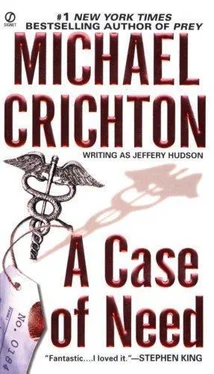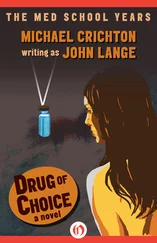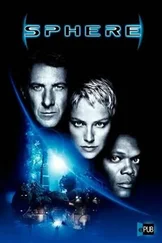Michael Crichton - A Case of Need
Здесь есть возможность читать онлайн «Michael Crichton - A Case of Need» весь текст электронной книги совершенно бесплатно (целиком полную версию без сокращений). В некоторых случаях можно слушать аудио, скачать через торрент в формате fb2 и присутствует краткое содержание. Город: New York, Год выпуска: 2003, ISBN: 2003, Издательство: Signet, Жанр: thriller_medical, на английском языке. Описание произведения, (предисловие) а так же отзывы посетителей доступны на портале библиотеки ЛибКат.
- Название:A Case of Need
- Автор:
- Издательство:Signet
- Жанр:
- Год:2003
- Город:New York
- ISBN:9780451210630
- Рейтинг книги:5 / 5. Голосов: 1
-
Избранное:Добавить в избранное
- Отзывы:
-
Ваша оценка:
- 100
- 1
- 2
- 3
- 4
- 5
A Case of Need: краткое содержание, описание и аннотация
Предлагаем к чтению аннотацию, описание, краткое содержание или предисловие (зависит от того, что написал сам автор книги «A Case of Need»). Если вы не нашли необходимую информацию о книге — напишите в комментариях, мы постараемся отыскать её.
A Case of Need — читать онлайн бесплатно полную книгу (весь текст) целиком
Ниже представлен текст книги, разбитый по страницам. Система сохранения места последней прочитанной страницы, позволяет с удобством читать онлайн бесплатно книгу «A Case of Need», без необходимости каждый раз заново искать на чём Вы остановились. Поставьте закладку, и сможете в любой момент перейти на страницу, на которой закончили чтение.
Интервал:
Закладка:
The counterargument is vague here. There is talk of mothers who unconsciously wish to conceive; talk of the maternal urge to procreate; flat statements that “there never was a child born who wasn’t wanted.” Or an ex-post-facto approach: once the child is born, the family will adjust and love him.
The fourth argument states that a woman should never, under any circumstances, be required to bear a child if she does not wish to do so. Abortion on demand should be a right of every woman, like the right to vote. This is an interesting argument, but its usefulness has been diluted by many of its proponents, who often express a rather paranoid feeling that the world is dominated by men who cannot be expected to show any sympathy for the opposite sex.
Those who disagree with this argument usually point out that a modern, emancipated woman need not become pregnant if she does not wish it. A wide variety of birth-control methods and devices is available to her, and they believe that abortion is not a substitute for birth control. The case of birth-control failure and inadvertent pregnancy—such as rape—are difficult to handle within this framework, however.
The fifth argument states that abortion is safe, easy, simple, and cheap; thus there can be no practical objection to legalizing termination of pregnancy.
The counterargument states that abortion carries a finite risk of mortality, which, though small, nonetheless exists. Unfortunately for this viewpoint, it is now perfectly clear that a hospital abortion is one-sixth to one-tenth as dangerous as a hospital delivery. This means it is safer to abort a child than to carry it to term.
The sixth argument is the newest and the most ingenious. It was first proposed by Garrett Hardin, and it attacks the problem at a crucial question: Is abortion murder? Hardin says no. He argues that the embryo does not become human until after birth and a long period of training. He states that the embryo is nothing but a template, ultimately derived from DNA, the information-carrying genetic substance. Information in itself, he says, is of no value. It is like a blueprint. The blueprint of a building, he says, is worthless; only the building has value and significance. The blueprint may be destroyed with impunity, for another can easily be made, but a building cannot be destroyed without careful deliberation.
This is a swift and oversimplified summary of his argument. Hardin was trained both as an anthropologist and as a biologist, and his viewpoint is unique. It is interesting because it considers the question of when is a person human in terms of what is a human being? Returning to the analogy of blueprint and building, the blueprint specifies size, shape, and general structure, but it does not state whether the building will be erected in New York or Tokyo, whether in a slum or an affluent area, whether it will be used effectively or fall into disrepair. By implication, Hardin is defining a human being not only as an animal that walks on its hind legs, has a large brain, and an opposable thumb; he includes in the definition enough maternal care and education to make a person a well-adjusted and functioning unit of a social grouping.
The counterargument says that Hardin assumes DNA is a “non-unique” copy of information, when in fact it is quite unique. All children of a given mother and father are not identical; therefore the DNA cannot be “non-unique.”
To this Hardin replies that we already, quite by chance, select only some of the potential DNA combinations of sperm and egg and allow these to reach maturation. He notes that an average woman has 30,000 eggs in her ovaries, yet will bring only a few to term. The others are destroyed just as surely as if they had been aborted. And, as he says, one of them might have been “a super Beethoven.”
Hardin’s argument is still new and strikes many as abstruse. But undoubtedly his is just the first of many new arguments, for and against abortion, which will be proposed on an increasingly subtle scientific basis. It is a commentary on modern man that he must justify his morality on the basis of the molecular mechanisms at work within a single cell of his body.
There are other arguments, but they are mostly evasive and petty. There are economic arguments concerning the cost of turning hospitals into abortion mills; there are vague and wild-eyed arguments of unleashed libertinism, similar to the arguments heard before the introduction of birth-control pills. There are also reflex liberal arguments that anything freer is by definition good and meritocratic arguments that the outpouring of children from the lower classes should be stemmed. There is no point in considering these viewpoints. They are advanced, for the most part, by thoughtless and irritable little men.
APPENDIX VII:
Medical Morals
IN MEDICINE TODAY, there are four great moral questions involving the conduct of medical practice. One is abortion. Another is euthanasia, the killing of a patient with a terminal and incurable illness. A third concerns the social responsibility of the doctors to administer care to as many people as possible. A fourth concerns the definition of death.
The interesting thing is that all these problems are new. They are products of our technology, moral and legal problems which have sprung up within the last decade or so.
Hospital abortion, for example, must now be regarded as a relatively inexpensive and safe procedure, carrying a mortality rate roughly similar to a tooth extraction. This was not always true, but in the modern context it is, and we must therefore deal with it.
Euthanasia was once much less serious a problem. When doctors had fewer “supportive” aids, artificial respirators, and knowledge of electrolyte balances, patients with terminal illnesses tended to die quickly. Now, medicine faces the fact that a person can be kept technically alive for an indefinite period, though he can never be cured. Thus the doctor must decide whether supportive therapy should be instituted and for how long. This is a problem because doctors have traditionally felt that they should keep their patients alive as long as possible, using every available technique. Now, the morality—and even the humanity—of such an approach must be questioned.
There is a corollary: whether the patient facing an incurable disease has the right to refuse supportive therapy; whether a patient facing weeks or months of terminal pain has a right to demand an easy and painless death; whether a patient who has put himself in a doctor’s hands still retains ultimate life-and-death control over his own existence.
Social responsibility in its modern terms—responsibility to a community, not an individual—is something rather new to medicine. Formerly patients who were indigent were treated by kind doctors, or not at all; now, there is a growing feeling that medical care is a right, not a privilege. There is also a growing number of patients who were once charity cases but are now covered by health insurance or Medicare. The physician is today being forced to reconsider his role, not in terms of those patients who can afford to seek his help, but in terms of all the people in the community. Related to this is the increased medical emphasis on preventive care.
The definition of death is a problem with a single cause: organ transplants. As surgeons become more skilled in transplanting parts from the dead to the living, the question of when a man is dead becomes crucial, because transplantable organs should be removed as rapidly as possible from a dead man. The old, crude indicators—no pulse, no breathing— have been replaced by no EKG activity, or a flat EEG, but the question is still unresolved, and may not be for many years to come.
Читать дальшеИнтервал:
Закладка:
Похожие книги на «A Case of Need»
Представляем Вашему вниманию похожие книги на «A Case of Need» списком для выбора. Мы отобрали схожую по названию и смыслу литературу в надежде предоставить читателям больше вариантов отыскать новые, интересные, ещё непрочитанные произведения.
Обсуждение, отзывы о книге «A Case of Need» и просто собственные мнения читателей. Оставьте ваши комментарии, напишите, что Вы думаете о произведении, его смысле или главных героях. Укажите что конкретно понравилось, а что нет, и почему Вы так считаете.









